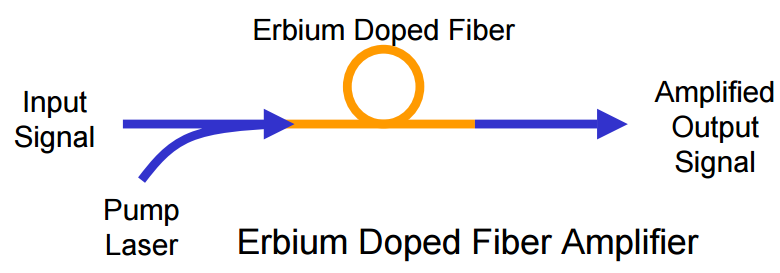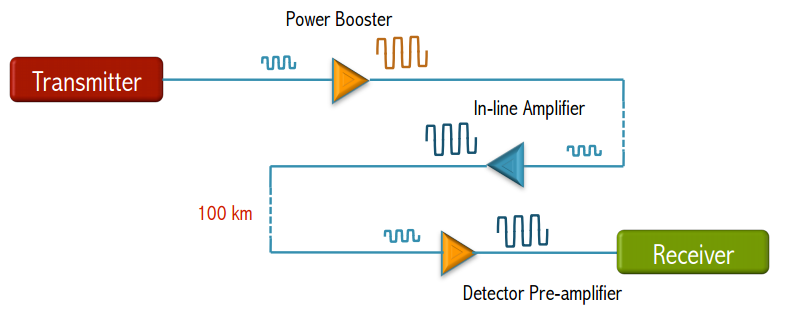An optical amplifier is a fiber optic device that can amplify optical signals directly without the need to convert it to an electrical signal. Optical amplifiers can increase the strength of the optical signal and allow the signals transmit through the cable over long distances. The emergence of optical amplifiers brings great improvement to networking and communication system.
There are three reasons. One reason is that the optical to electrical and electrical to optical conversions requires high-speed electronics and costs too much. The other reason is that signals carried by a fiber will be attenuated because no fiber material is absolutely transparent. Then repeaters must be used in the optical fibers which maybe longer than 100 kilometers. And the last one is that the signal-to-noise ratio of detected signals is too low and bit error rate becomes too high. So the most efficient and best optical method is an optical amplifier. Optical amplifiers could avoid the need for E-O and O-E conversions. It’s beneficial to compensate for attenuation losses during signals transmitting over long distances.
There are three types of optical amplifiers: rare earth doped fiber amplifiers (the most popular one- Erbium Doped Fiber Amplifiers), semiconductor optical amplifiers, Raman amplifiers. But the question is which one is suitable for your specific transmission system. By the following comparison you may find the answer.
Erbium doped fiber amplifiers (EDFAs): they have high pump power utilization. Amplifiers can directly and simutaneously amplify a wide wavelength band (>80nm) in the 1550nm region with a relatively flat gain. And EDFAs have low noise, which is suitable for long haul applications. However, compared with other two kinds of amplifiers, EDFAs can’t be integrated with other semiconductor devices and can obtain small signal gain only in a specific frequency band.

Semiconductor optical amplifiers: they are of small size and electrically pumped. Its high optical nonlinearity is good for all optical signal processing like optical switching and wavelength conversion. SOA provides the possibility for gain in different wavelength regions. The gain reacts rapidly to changes of pump or signal power and the changes of gain cause phase changes which can distort the signals. Compared with EDFA, SOA has higher noise, lower gain, moderate polarization dependence and high nonlinearity with fast transient time. However, it’s less expensive than EDFA and can be integrated with semiconductor lasers, modulators, etc.
Raman amplifiers: they gain exists in every fiber, which provides a cost-effective means of upgrading from the terminal ends. Furthermore, the gain is nonresonant so that it’s available over a wide transparent region of fiber. And the gain spectrum can be tailored by adjusting the pump wavelength. Compared with EDFA, Raman amplifiers have relatively poor pumping efficiency at lower signal powers and require a longer gain fiber.
The main purpose of this article is to give you suggestions to obtain a high transmission capacity over long distances. Optical amplifiers are quite important elements in wavelength division multiplexing (WDM) system. You may apply DWDM (dense wavelength division multiplexing) or CWDM (coarse wavelength division multiplexing). And these optical amplifiers could be used in both DWDM and CWDM transmission system. So you don’t need to take this as a problem for imrpoving your signal quality.
